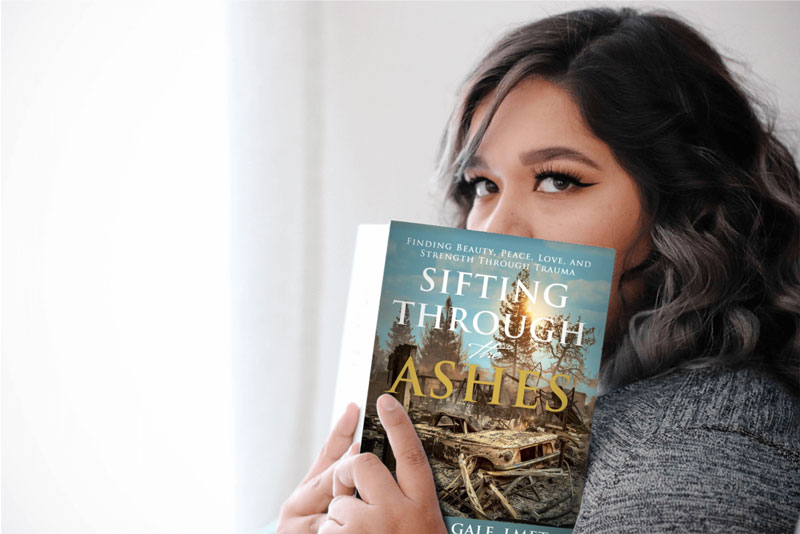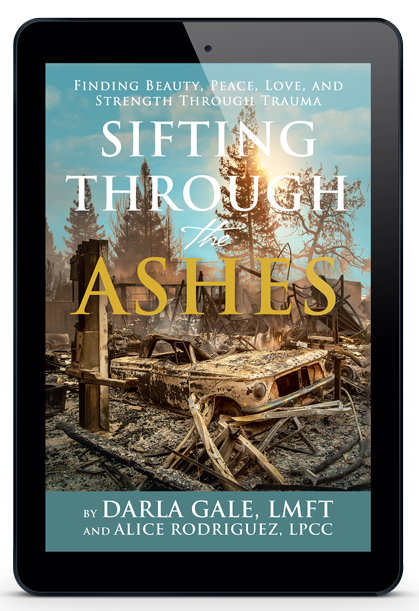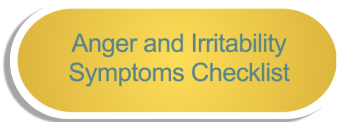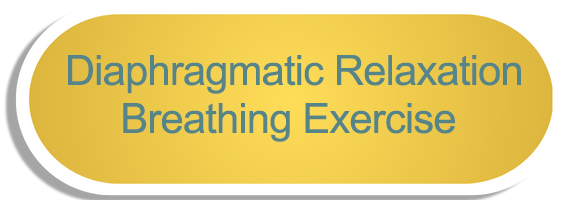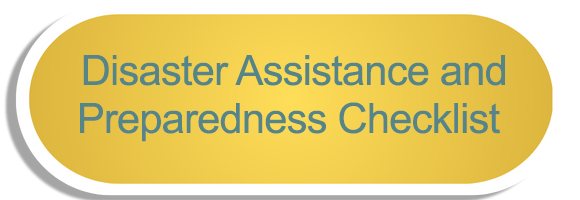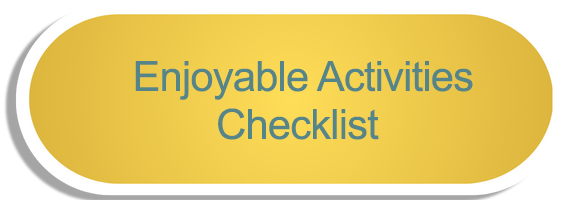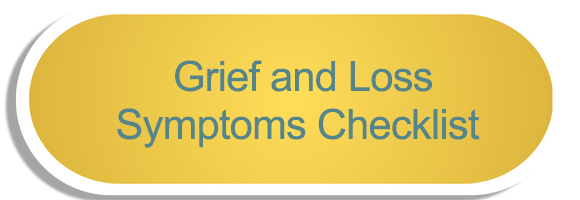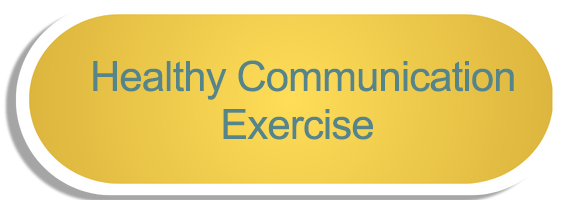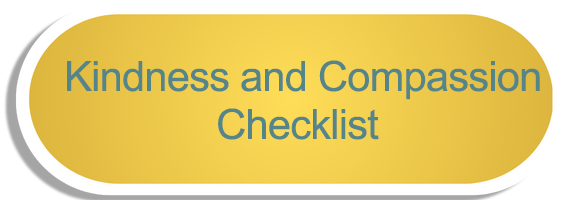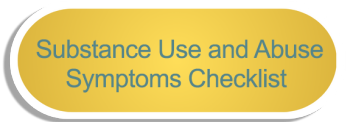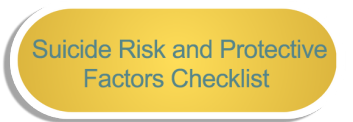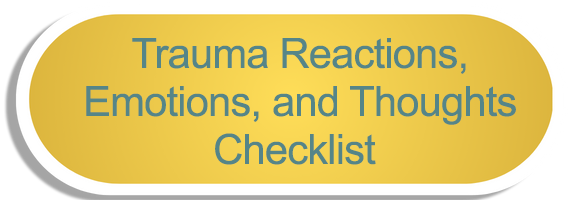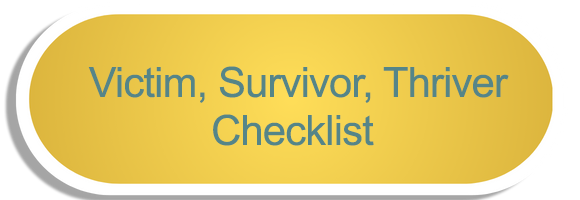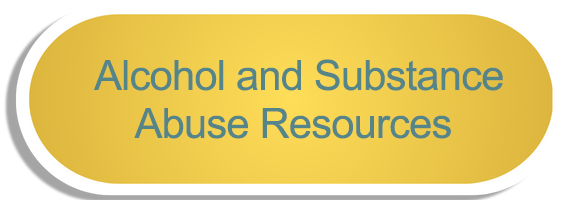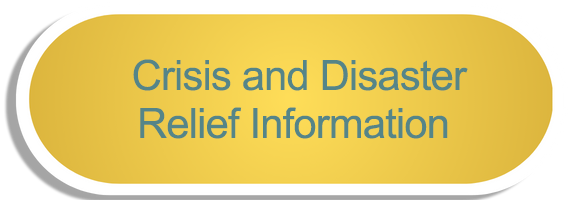IMMEDIATE SYMPTOM RELIEF TRAUMA TOOL KIT
I am thrilled that you have chosen to access the Immediate Symptom Relief Trauma Tool Kit. This resource was designed with the intention of providing relief for individuals who struggle with anxiety, PTSD, depression, and other mental health symptoms. It is my hope that through this tool kit, you will find beauty, peace, love, and strength in your journey of healing from trauma.
The path of healing from trauma is not an easy one, but it is possible to move from being a victim to a survivor and eventually, a thriver. It takes courage, determination, and support to overcome the effects of trauma, and this tool kit aims to provide all three.
One of the key elements in this tool kit is learning how to manage immediate symptoms. Traumatic experiences can trigger overwhelming emotions and physical sensations, which can be difficult to cope with. The tools provided in this kit will guide you through techniques to regulate these symptoms and find relief.
It is important to remember that healing from trauma is a unique journey for each individual. What works for one person may not work for another. Therefore, this tool kit emphasizes the importance of self-care and finding what works best for you. Self-care is not a luxury, but a necessity in the healing process.
I want to assure you that there is hope on this journey. With the right tools, support, and mindset, it is possible to not only survive but thrive after experiencing trauma. This tool kit is just the beginning of your healing journey, and I am grateful to be a part of it. Remember to be gentle with yourself, take things one step at a time, and reach out for support when needed.
Together, let us break the stigma surrounding trauma and mental health and pave the way towards healing and empowerment. You are not alone on this journey, and I am honored to walk alongside you. Stay strong, stay resilient, and know that you are capable of overcoming any obstacle. Let’s begin this journey towards finding beauty, peace, love, and strength through the trauma we have endured.
How to Use the Sifting Through the Ashes Checklists, Exercises, Techniques, and Resources
Start with our Checklists. These are designed to help structure the process of understanding your traumatic experiences so you can begin to heal. As you go through them, take the time to reflect on each item and answer honestly.
Once you’ve completed the Checklists, move on to our Exercises. These exercises are designed to help identify triggers and facilitate emotional regulation skills. Take it slow; if an exercise feels overwhelming, take a break or even skip it altogether — healing is all about progress, not perfection!
Next, try out some of the Techniques. These are designed to provide you with tools and strategies to cope with traumatic memories and symptoms in a safe and effective way.
Finally, check out our Alcohol and Substance Abuse Resources, Crisis and Disaster Relief Information, and Suicide and Distress Crisis Lines. Here you’ll find helpful phone numbers and websites that can further aid your healing journey. We recommend bookmarking this page so you can easily come back for continued guidance.
Therapist’s Book Offers Guidance and Hope for Survivors of Trauma, Disaster and Crisis: Sifting Through the Ashes: Finding Beauty, Peace, Love, and Strength Through Trauma
Is Your Anger-O-Meter Going Through the Roof? Check Out This Anger and Irritability Symptoms Checklist!
This checklist is designed to help you recognize the signs of anger in yourself and others so that you can learn to manage it better. Remember, it’s important to stay conscious of your emotions and take time to cool off when needed. Keep this checklist handy and use it as a helpful tool! So, have you checked your Anger-O-Meter lately? It’s time to take a moment and check in with yourself. Use this checklist as a guide for de-stressing and getting back on track. Good luck! See how many of these signs of irritability apply to you right now!
Take Control of Your Anxiety: The Anxiety Symptoms Checklist Is Here!
Using an Anxiety Symptoms Checklist can be a great way to help you identify the common signs and symptoms of anxiety. It’s like having a personal check-in with yourself to make sure you’re OK. With this tool, you can take charge of your mental health and become aware of any warning signs that could be pointing to an oncoming episode of anxiety. Have the checklist handy and use it to get a better handle on your mental well-being. It’s an easy way to keep tabs on yourself. So, use the Anxiety Symptoms Checklist often and keep an eye out for those pesky signs of anxiety!
Take the Boundaries Checklist Challenge Today!
A boundaries assessment can be a great way to gain clarity, develop self-awareness, and get in touch with your feelings. It’s like shining a light on what matters to you and who you are as an individual – helping you discover where you should draw the line and set limits when it comes to relationships of all kinds. By learning more about yourself and acknowledging your needs, you can have healthier, happier relationships with those around you! Who wouldn’t want that? So why not take the time to do a boundaries assessment today? It could be just what you need to build better relationships.
Taming Your Mind: A Cognitive Behavioral Therapy Exercise for Managing Thoughts, Feelings, and Behaviors
Managing thoughts, feelings, and behaviors is important for a healthy and resilient lifestyle. Through cognitive behavioral therapy (CBT), individuals can gain insight into how their current mental state influences their behavior in different situations. Doing so enables them to effectively manage tough emotions and make better decisions which leads to improved relationships and overall well-being. Learning to manage thoughts, feelings, and behaviors can be a rewarding journey that gives you the tools needed to maximize your potential. Try this CBT exercise today and experience the difference!
Are You Suffering from Complicated Grief? Take This Checklist to Find Out!
Complicated grief is often characterized by intense and prolonged feelings of sadness, guilt, anger, loneliness, and despair that do not lessen over time. Recognizing complicated grief symptoms in yourself or others can be an important first step in managing grief. Complicated grief is not an easy journey, but it is possible to overcome its symptoms with time and support. With proper intervention, individuals can learn how to accept the loss while still living life and finding joy in the present. It is important to recognize that healing can take time and there is no one-size-fits-all approach to complicated grief. However, with patience and support, those experiencing complicated grief can find a path towards peace.
Checking In: A Couple's Self-Assessment Guide
A couples coping checklist can be a lifesaver for those going through a traumatic event. It helps to ensure both partners are on the same page about what kind of support each needs and keeps communication lines open. Plus, it gives you an opportunity to make sure that no one is shouldering all the emotional burden alone—you’re in it together! It’s a great way to make life a little easier when things are especially tough. So why not give it a try? You just might find that it helps you both get through the hard times and come out on the other side even stronger!
Crisis Safety Plan: Strategies for Suicide Prevention and Intervention
The focus of this Crisis Safety Plan is to provide guidance, support, and resources to individuals who are experiencing suicidal thoughts or behaviors. This plan outlines essential strategies to promote safety and provide support when suicide is a risk. By following the steps outlined in this plan, individuals in crisis can be better equipped to manage their emotions and find access to resources that may help them cope with difficult situations. Through proactive measures, the risk of suicide can be minimized, and individuals can be empowered to seek help when needed. A Crisis Safety Plan is a valuable tool to provide individuals in distress with an actionable plan that helps them find the help they need to get through difficult times.
A Comprehensive Checklist for Spotting the Signs and Symptoms of Depression
A Depression Symptoms Checklist can be a great tool to help you determine if there are any changes in your mood or behavior that might indicate you’re struggling with mental health issues. It’s simple, fast, and can provide invaluable insights into how you’re really feeling inside. Plus, it helps you keep track of things over time so you can see if anything is getting better or worse. Don’t be afraid to make use of this awesome resource – it’s definitely worth a try! It might just help you get to the root of whatever moody issues you’re dealing with and take the necessary steps to start feeling like yourself again!
Breathe In, Breathe Out: How to Relax Your Body with a Simple Breathing Exercise!
By taking the time to practice diaphragmatic breathing, it can help reduce stress and anxiety by bringing awareness back to the body and calming any unrest within. By regularly practicing diaphragmatic breathing, you can gain greater awareness of your physical and psychological states and develop a healthier relationship with your body. With consistent practice, you will be better equipped to manage stress and anxiety in any situation. It is important to remember that, if at any point during the practice you feel overwhelmed or uncomfortable, it is completely normal and ok to take a break. The goal of this practice is to bring about relaxation, not stress.
Ready, Set, Be Safe: Your Essential Disaster Preparedness Checklist
Making sure you’re prepared for the unexpected is an essential part of life. After all, you never know when Mother Nature might decide to make an appearance. So why not equip yourself with the knowledge and items needed to stay safe in a time of crisis? A disaster preparedness checklist is the perfect way to do just that! Whether you’re a homeowner, business owner, or simply someone who lives in an area prone to natural disasters, having a plan of action can save your life. Taking the time to create and maintain an emergency checklist will help make sure you are prepared when disaster strikes. So don’t wait, get prepared today!
Unlocking Trauma Through a Dream Log: Harnessing the Power of Your Subconscious Mind
Dream logging is the practice of recording dreams in a journal or notebook. It can be done either as soon as you wake up, while the memory of your dream is still fresh in your mind, or later during the day. Some people even keep their log beside their bed to make it easier to write down details right after they wake up. Dream logging is an effective way to learn more about your subconscious and can help you to make sense of what you dream. By recording your dreams, you create a dialogue with yourself that allows you to better understand the meaning behind them. It’s also a great way to cultivate mindfulness and be more aware of patterns in your thinking.
100 Fun and Enjoyable Activities to Brighten Your Day!
Having an Enjoyable Activities Checklist can be a great way to make sure you’re taking that much needed “me” time. From pampering yourself with your favorite spa treatment to trying out a new hobby, it’s the perfect way to remind you of all the things that bring joy into your life. Plus, having this list handy makes it easy to find something fun when the boredom sets in! Unleash your inner creativity and discover activities you never even knew existed. Treat yourself and have a blast – you deserve it.
Grief and Loss Symptoms: A Comprehensive Checklist
The grieving process is one that everyone goes through at some point in life, but it often feels like an isolating experience. To help you recognize the signs of mourning and understand what comes with it, we have created a Grief and Loss Symptoms Checklist. This guide will give you a better understanding of the emotions, physical responses, and mental exhaustion that can come with grief. We hope this checklist provides comfort and guidance as you navigate through your journey of healing.
Awareness is Better Than a Blur: A Grounding Exercise for Your Environment
Grounding exercises can be a real lifesaver when it comes to managing stress and anxiety. They help you reconnect with the present moment, focus on your breath, and bring yourself back down to earth. By taking a few minutes out of your day to practice grounding techniques, you can quickly get back in control of your emotions and remain calm under pressure. Plus, they’re super relaxing – what’s not to love? So go ahead and take a breath – your mental health will thank you later! Another great thing about grounding exercises? They’re completely free, quick and easy – no gym membership or fancy equipment required! And you can do them almost anywhere: at home, in the car, even on a plane or train. All you need is a few moments of stillness to take some deep breaths, focus on your body and let go of any tension. So why not give it a try? It could be just the break from stress that you need! Happy grounding!
Let's Talk it Out: Practicing Healthy Communication
Practicing healthy communication is key to having successful relationships, both personally and professionally. Not only does it help us express our thoughts and feelings clearly, but it also helps us build meaningful connections with the people around us. Plus, who doesn’t love feeling heard and understood? So let’s make an effort to practice healthy communication and start strengthening our connections today! It’s time to let go of the unhelpful habits we all know too well and start communicating in a way that serves us better. From making our intentions clear to offering understanding and empathy, healthy communication is the way forward for all of us. Let’s give it a go!
Bouncing Back: A Checklist for Human Resiliency
A Human Resiliency Checklist is a great tool to help individuals recognize and address their own needs for emotional, mental, physical, and spiritual wellness. It helps them evaluate aspects of their wellbeing and develop strategies that will support their overall health. By using this checklist, users can identify areas in which they may be struggling or vulnerable to stressors and create action plans to better manage these issues. Additionally, it will help them recognize their own strengths and use those to build resilience. This can be a powerful tool for both personal growth and maintaining wellbeing during challenging times.
Kindness and Compassion in Action: A Checklist for a Better You!
A Kindness and Compassion Checklist can help you stay on track with your goals of spreading positivity! This checklist can remind you to engage in small, meaningful acts of kindness each day. Whether it’s a simple compliment or offering a listening ear, these kind gestures can have a huge impact on someone else’s life and make the world just that much brighter. Plus, when we show kindness to others, we also receive a mood boost that can help us feel content and compassionate towards ourselves, too! So why not give it a try? You’ll be surprised with how much joy you find in the little things.
Relax, It's All in the Muscles: A Guide to Progressive Muscle Relaxation
Progressive Muscle Relaxation (PMR) is an effective way to manage the symptoms of trauma. By slowly tensing and releasing each muscle group, you can reduce physical tension in your body and learn how to better cope with emotional distress. Studies have shown that PMR can reduce physical symptoms associated with stress such as tension headaches and muscle cramps, while also helping you process emotional experiences more effectively. Plus, when done regularly, PMR can help you more effectively handle the stress and triggers that come with trauma. So go ahead – give it a try! You deserve all the relaxation you can get.
Rock Your Way to Mindfulness: A Technique for Calming the Mind
Rock Mindfulness can be a great way to take time for yourself and find some inner peace. It can help to reduce stress, increase awareness, and gain clarity of thought. It can also help cultivate patience and gratitude, enabling us to be more mindful in our day-to-day lives. Rock Mindfulness is an incredibly helpful tool for managing stress and staying present. It gives us the ability to be in full control of our thoughts and how we react to situations. Through mindfulness, we can become aware of what’s going on inside us, taking note of emotions and reactions to difficult moments, and taking back control. It’s a great way to have fun while also taking care of our mental health, as it’s a creative and inspiring practice. With Rock Mindfulness, you can feel more relaxed and content in your everyday life!
Escape from Stress with a Visualization Retreat: A Safe Place to Recharge and Refresh!
It can be difficult to find a safe place when you’re feeling overwhelmed by traumatic events in your life. But with the help of visualization techniques, you can create a virtual refuge that is accessible anytime, anywhere. Let us take you on a journey to create your own safe place visualization and provide you with the necessary tools to maintain a sense of peace and security in times of distress. With practice and dedication, we can help you find the calm amidst the chaos. So join us for a virtual retreat – let’s get started!
The Power of Positive Self-Esteem: A Checklist to Boost Your Confidence
A Self-Esteem Assessment can be a great way to give yourself a confidence boost! Taking the time to think about all your positive qualities and accomplishments can be a great help in challenging negative thoughts and feeling better about yourself. Doing an assessment like this can also give you valuable insight into where your strengths lie, so you can better focus on building up your self-esteem and being happier in life! Check it out.
The Art of Self-Soothing: How to Calm Your Nerves Without Spending a Cent
Self-soothing exercises are like a mini spa day for your mind. In just minutes, you can relax and reduce stress levels. Self-soothing exercises can be an important tool for de-stressing in a matter of minutes. Research suggests that taking just five minutes out of your day to practice mindful breathing, journaling, or listening to music can have profound effects on reducing tension and calming the mind. Just take a few moments and give yourself the gift of relaxation. You deserve it! And who knows, you might just find yourself feeling more relaxed and at ease afterwards. So go ahead, take a few minutes and give yourself some much needed self-love! Let the soothing begin.
Ready, Set, Affirm: A Checklist for Confidence-Boosting Self-Affirmations
A Self-Talk Affirmations Checklist is an amazing way to help boost your confidence and inner strength. It’s like having a personal cheerleader in your pocket! Each time you glance at the list, it reminds you of all the great things about yourself that you may have forgotten over time. Plus, affirming those positive thoughts helps to keep them fresh in your mind and provide extra motivation when you need it! This checklist can be a great way to stay positive, focused, and productive. Try it out today and see how much of an impact it can have on your life!
Head to Toes: A Somatic Breathing Adventure!
Take a journey down your body and calm your mind with this somatic breathing exercise. Let the breath flow from your head, all the way to your toes, as you relax and focus on each area of your body. Feel the tension melt away with every inhale and exhale. Ready to get started? Let’s go on a ‘Head to Toe Relaxation Adventure’!
Exploring the Impact of Substances on You: A Checklist for Self-Reflection and Understanding
A Substance Use and Abuse Checklist can be super helpful if you’re trying to learn more about yourself and your relationship with substances. It’s like having your very own personal accountability partner! By using this list, you can gain a better understanding of how substances are affecting your life. This checklist can help you identify potential signs of substance use and abuse. It can provide insight into the relationship between your use of substances and the physical, behavioral, and psychological areas of your life and overall wellbeing. Moreover, it can help you to recognize the warning signs of addiction and take appropriate steps to seek help. It’s important to be honest with yourself when completing this checklist, as it can provide valuable insights and help you to make more informed decisions. Taking the time to do this can be an important step towards a healthier lifestyle.
A Checklist for Assessing Suicide Risk and Protective Factors
Using a Suicide Risk and Protective Factors Checklist can help someone recognize their mental health status, identify the risk factors they have been exposed to, and determine key protective factors they can use to reduce their risk. The checklist helps an individual to understand the potential risks and challenges in their life, as well as the strengths and resources available to them. By assessing their situation, someone can gain better insight into their mental health and develop an action plan for managing or reducing their risk of suicide. A checklist can also provide a starting point for further research and intervention services (see the Suicide and Distress Crisis Lines). Ultimately, using a Suicide Risk and Protective Factors Checklist is a great way to help keep yourself safe.
Turning Negative Thoughts Around With CBT: A Guide to Reframing Your Mindset
Thought reframing is a great way to identify negative thoughts and reframe them in a new light, allowing you to gain new perspectives. It can help identify any unhelpful thinking patterns that may be holding you back from achieving your goals. By reframing your thoughts, you’re able to change how you view the world and take action to make your life easier. Plus, it’s a great way to look at things differently! Give it a try today and see what reframing can do for you. You might be surprised by the results! See what amazing possibilities you can open up. You never know what kinds of opportunities await when you change the way you think!
How to Identify Reactions, Emotions, and Thoughts in the Face of Trauma: A Checklist for Navigating Unfamiliar Territory
A Trauma Reactions, Emotions, and Thoughts Checklist can help individuals who have experienced a traumatic event identify the intense and often confusing emotional, cognitive, and physical reactions they may be experiencing. It can be used as a self-assessment tool to help individuals better comprehend the effects of their traumatic experience and move forward in healing. The checklist can provide a valuable source of insight, helping individuals understand their own experience to process and overcome the trauma. This can also help create an open dialogue between individuals and their mental health professionals, ensuring that they are getting the most effective treatment possible.
Are You a Victim, Survivor, or Thriver? Take Our Checklist to Find Out!
Making the transition from a victim to a survivor to a thriver isn’t easy, but it is possible! You just have to be brave and take small, manageable steps. Start by recognizing what you have control over and taking responsibility for your choices and actions. Then, focus on building a positive mindset and creating a plan to take charge of your life. Finally, use all the tools and resources you have at your disposal to create lasting change. Taking the initiative by stepping out of a victim mentality, embracing your inner strength, and moving towards a life of resilience is the key. The road may be bumpy, but if you stay dedicated and focused on your goals, you’ll soon find yourself emerging as a true thriver. So what are you waiting for? Take the courageous step towards taking charge of your life and becoming the best version of yourself! You’re worth it. Happy thriving!
Soaring Through Sobriety: Get the Support You Need for Alcohol and Substance Abuse
Alcohol and substance abuse can be hard to overcome without help. There are numerous resources available that can provide support and guidance on the road to recovery. With the right help, anyone struggling with addiction can take back control and start living a healthier, happier life. So, if you or someone you know is looking for help, don’t be afraid to reach out. It can make all the difference in your journey. It might just be the best decision you ever make! You got this!
Be Prepared: A Guide to Phone Numbers and Websites for Crisis and Disaster Relief
Crisis and disaster relief phone numbers and websites are essential resources in times of emergency. They provide people with immediate access to important information, advice, and support. With a simple call or online search, individuals can get access to critical resources that can help them manage difficult situations. The most important phone numbers and websites can be easily stored in a smartphone or memorized for quick access when needed. Knowing the right phone numbers and websites to call in times of crisis can be life-saving. It is important for everyone to familiarize themselves with these resources and make sure they are always prepared in the case of an emergency. By ensuring that these important phone numbers and websites are readily available, individuals can feel secure knowing that they have a reliable source of help in times of crisis or disaster.
Don't Be Afraid to Pick Up the Phone: A List of Suicide and Distress Hotlines at Your Fingertips
Suicide and distress phone numbers are incredibly important because they provide people in need with an immediate source of help. They give individuals a way to call for help quickly and effectively, without having to worry about being judged or criticized. These numbers are also invaluable for those who may not have access to traditional forms of mental health care or may not be able to afford it. Connecting with a friendly, understanding individual at a suicide or distress phone number can be life-changing, and can provide a sense of hope and courage to those in critical need. In short, these phone services can save lives.
The devastating Camp Fire of 2018 left many people traumatized and without a home. Soon after the fire, Gale decided to help survivors process their trauma by providing therapy sessions for the community. Sifting Through the Ashes was born from these interactions, and its purpose is to provide stories, clinical guidance and practical tips for those who have suffered a traumatic event of any kind.
“PTSD is like a prison in your brain…it gets trapped in your brain: sights, sounds, smells,” Gale said in a recent interview. “But the cool thing is it doesn’t have to be a life sentence.”
Sifting Through the Ashes features real stories from survivors of the 2018 Camp Fire, and Gale invites readers to journey alongside the survivors as they share their experiences and search for strength and resilience in the face of tragedy.
Clinical guidance and helpful tips for self-care are also included to help readers process their own experiences. The book provides self-help exercises; psychoeducation on mental health topics like PTSD, anxiety and depression; and other valuable resources.
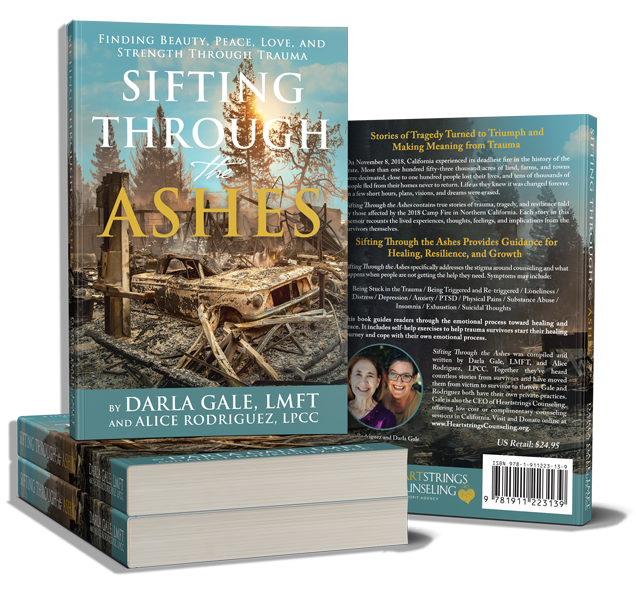
Sifting Through the Ashes aims to be an impactful read for survivors of fires and other disasters, first responders, anyone with PTSD, and therapists who work with trauma survivors.
“It is a powerful reminder that we can all rise above even the darkest of moments and find hope in the midst of darkness,” Gale added.

